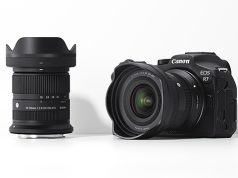When is a threat an opportunity? That’s a question worth pondering about digital picture frames as we move deeper into the fourth quarter. They’re likely to be a top choice gifting item for the affluent this holiday season, as more discover the advantages of these electronic solutions for displaying their images. But is pushing a product which has the long-term potential to further undermine demand for prints at retail in your best interest?
It resurrects an issue imaging specialists had to face early on in this digital era with regard to print-at-home solutions. The question then was whether to support and promote products which could put the consumer in the print business for themselves. Responses were as varied as retail strategies: some have simply avoided the category; others have a modest presence in a pitch to capture what sales they can; a few aggressively promote home printing, reasoning since consumers will buy these printers and consumables anyway, they might as well get them from the imaging specialist.
Time and trends have shown that print at home is not the insurmountable challenge it may have seemed. Consumers have learned it’s costly and time-consuming to produce all their prints at home, and it can actually be cheaper to get what quality prints they want at retail. But, new habits are in place. Digital camera owners are taking more pictures overall, and a sizable share of those images never make it past the monitor or LCD screen. They’re producing “good enough” prints for casual sharing on home printers, even on standard copy paper. And they’ve also started turning to retail in greater numbers for digital prints.
Frame Flexibility
Now consider the digital photo frame, a product and concept launched several years ago but just now really starting to take hold. First and foremost, it’s another threat to the print model. Here’s an alternate approach for exhibiting photos, or a succession of pictures, wherever there’s now a framed print. Like the digital camera, the core appeal of digital picture frames is in things it allows people to do with photos that just weren’t practical with prints on paper. Change the photo with the mood. Create an ever-changing slide show of favorite images on view by the minute or hour, throughout the day. Gift a self-contained album of photos to family and friends which they can later update electronically.
All of this bypasses printing; printing does not even enter into that picture. That’s not to suggest printing will ever completely disappear…but if digital photo frames really take hold as it appears they may, printing could become a secondary consideration for many photos which are now framed “keepers.”
Now, consider the opportunity: this is a product category on the upswing. Market research firm Parks Associates estimates sales in the category quadrupled between 2005 and 2006, squashing original estimates, with sales of 1.7 million frames. Senior analyst Harry Wang, author of the company’s white paper “Digital Photo Frames: Picture A Good Year” hedges on projecting sell through for this year, predicting only ‘it should be another sellout year for both manufacturer and retailers.”
The company did revise its long-term sales projections upward earlier this year. By 2010, Parks Associates now predicts annual U.S sales should top 8.7 million units. Research firm IDC paints an even rosier picture in its Digital Frame 2007-2011 Forecast released in September. It estimates put the U.S. market at 22.8 million units by 2011.
No matter whose numbers you believe, there’s a lot at stake. When prices fall to levels where these become a truly mainstream option for all consumers, these frames, or some future variation on them, could become the final destination for many digital photos now printed or enlarged.
The biggest risk is that specialty dealers could surrender those sales to other channels. When asked about the primary retail channels for sell through of digital photo frames, Wang quickly names big box retailers, major discounters, even office supply and furniture stores. Traditional camera specialty dealers are minor blips on his horizon, though they may have the most to win or lose from this category.
Wang is one of these who looks ahead and thinks in terms of display, rather than print, as emerging as the preferred means for sharing photos. That may not be a message the traditional photo industry wants to hear, but it resonates with other changes wrought by digital imaging. Digital frames merely respond to practices already popular, allowing users to display the same kinds of images in their home or office they’re already enjoying as wallpaper, slide shows and screen savers on their monitors.
To date, Wang says, digital picture frames have been primarily bought as gifts, making them an especially lucrative product this time of year. Last May 112,000 frames were sold in the week leading up to Mother’s Day, according to NPD Techworld generating $112 million in sales. But Wang says the category won’t really come into its own until Americans start buying these products for themselves as a display solution. That trend will likely be accelerated as major vendors, with deep promotional pockets, follow the lead of Kodak and other early proponents, and help establish digital frames as a legitimate, mainstream product.
Price Sensitive
Pricing should help broaden their appeal, as well. Wang expects the most popular sized frames of 7-inches or less will be selling between $50 and $100 this year. Demand could outpace supply as we get closer to the holidays, bringing some price stability. At larger frame sizes, discounting could become more of a factor. Across the board, the category will benefit from every effort to advertise and promote them, as consumer awareness is still relatively low, given their market potential.
And it’s what the consumer finds at the point of sale that can do most to boost sales, he notes. As a new concept product, these are items which play to the strength of the specialty retailer as the one who can explain and demonstrate the value of new technologies. Although digital frames are easy to use and load, most shoppers must first be shown how simple that is before they confidently buy or give them. The user interface for loading, selecting and displaying pictures is a key selling point.
Picture quality is also paramount. As with televisions, monitors, and LCD screens, there can be noticeable differences in the image. If shoppers are introduced to products with a poor display quality or struggle with a poorly designed interface they’ll look for other ways to spend their gift dollars. Wang points out that if the initial experience with a digital photo frame is not satisfactory it could be years before the giver or recipient is back in the market for another frame.
New Habits Die Hard
Digital photo frames have the potential to be as disruptive as digital cameras were to the status quo. By taking the versatility of digital imaging out of cameras and computers and onto the wall, they will erode demand for prints and enlargements. In that, they are cementing trends already in place in the ways people share and use their digital images. Some already carry their “wallet” of photos in their phone or iPod; now they can electronically frame their favorites for the wall, desk or table.
Note that some of the latest, high-end digital photo frames include built-in wireless capabilities. That may initially appeal to early adopters, equipped to transmit or retrieve images over a network or to/from their wireless-enabled hardware.





